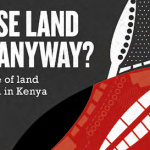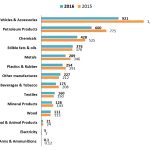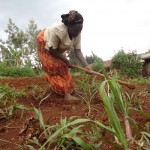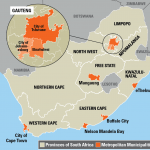The Awards Ceremony for the inaugural Haller Prize for Development Journalism took place in Nairobi on Tuesday 18th November 2014. Our Director Edward Paice chaired the prize’s panel of judges, which included: Obinna Anyadike (Editor-in-Chief, IRIN), Mary Harper, (Africa Editor, BBC World Service) and Yasiin Mugerwa (Chief Political Reporter, The Daily Monitor, Uganda).
The evening also included a round table discussion, “Does Africa Need Development Journalism?” with Aidan Hartley (author, foreign correspondent and film-maker), Maimouna Jallow (journalist and Senior Program Manager at the African Media Initiative), Michael R Meyer (founding Dean of the Graduate School of Media and Communications at the Aga Khan University) and Caroline Mutoko (presenter of Nairobi’s Kiss 100 FM radio station).
Listen to Edward’s introduction, the roundtable discussion and acceptance speeches:
Winning entries
The first prize of £3,000 was awarded to Nelson Chenga, second prize of £1,000 went to freelance journalist Issaka Adams, third prize of £500 went to Valentine Obara and Asha Jaffar received the Chairman Of The Judges’ Special Award. The winning entries can be read below:
-
 Nelson Chenga is the Senior Features Writer at Zimbabwe’s leading business weekly, The Financial Gazette. He has been a journalist for 24 years, working as a freelancer and for Zimbabwe’s biggest daily paper The Herald before joining The Financial Gazette. During this time he has specialised in developmental issues, in particular looking at the way in which environmental affairs impact on poorer communities.
Nelson Chenga is the Senior Features Writer at Zimbabwe’s leading business weekly, The Financial Gazette. He has been a journalist for 24 years, working as a freelancer and for Zimbabwe’s biggest daily paper The Herald before joining The Financial Gazette. During this time he has specialised in developmental issues, in particular looking at the way in which environmental affairs impact on poorer communities.Nelson’s First Prize Winning Article:
Funding Gone Down the Drain
In 2010 and 2011, the United States Agency for International Development (USAID) sponsored programmes in many of Zimbabwe’s marginal, drought-prone districts as it sought to assist vulnerable communal farmers improve agricultural production.
Through the Reviving Smallholder Farmers’ Marketing of Agricultural Products (RSF-MAP), which was implemented by the Catholic Relief Services (CRS/ZW) and a local partner, the Community Technology Development Trust (CTDT), USAID hoped, among other things, to address institutional economic factors that normally prevent vulnerable smallholder farmers from participating in lucrative markets where better returns for their crop and livestock sales can be realised.
RSF-MAP, part of USAID’s disaster risk reduction initiative in southern Africa, was born out of the general realisation that countries in the region perpetually face chronic droughts, floods, cyclones, food insecurity, disease outbreaks and complex humanitarian emergencies that often present serious challenges to vulnerable communities.
Using the value chain approach, the RSF-MAP programme hoped to link market-oriented production to targeted value chains such as horticulture, groundnuts and small livestock, to help increase income available to villagers for the procurement of food and other household necessities.
However, three years down the line, part of USAID’s US$1.1 million RSF-MAP grant that targeted approximately 30,000 families in Mudzi District in Mashonaland East province, has literally disappeared.
Three small livestock auction pens established in the district are fast being swallowed by the savannah countryside as inactivity undermines USAID’s small livestock auction pen programme. Thorny acacia shrubbery is thriving as all the established sites go unused and unmaintained.
When I happened upon one of the auction pens at Kapotesa in June 2012, journalistic instinct prompted me to take a picture of the fallen billboard at the project. The sight of the billboard with the background of the neatly constructed auction pens looked newsworthy. But newsdesk gatekeepers back in the capital Harare thought otherwise. I kept the picture anyway.
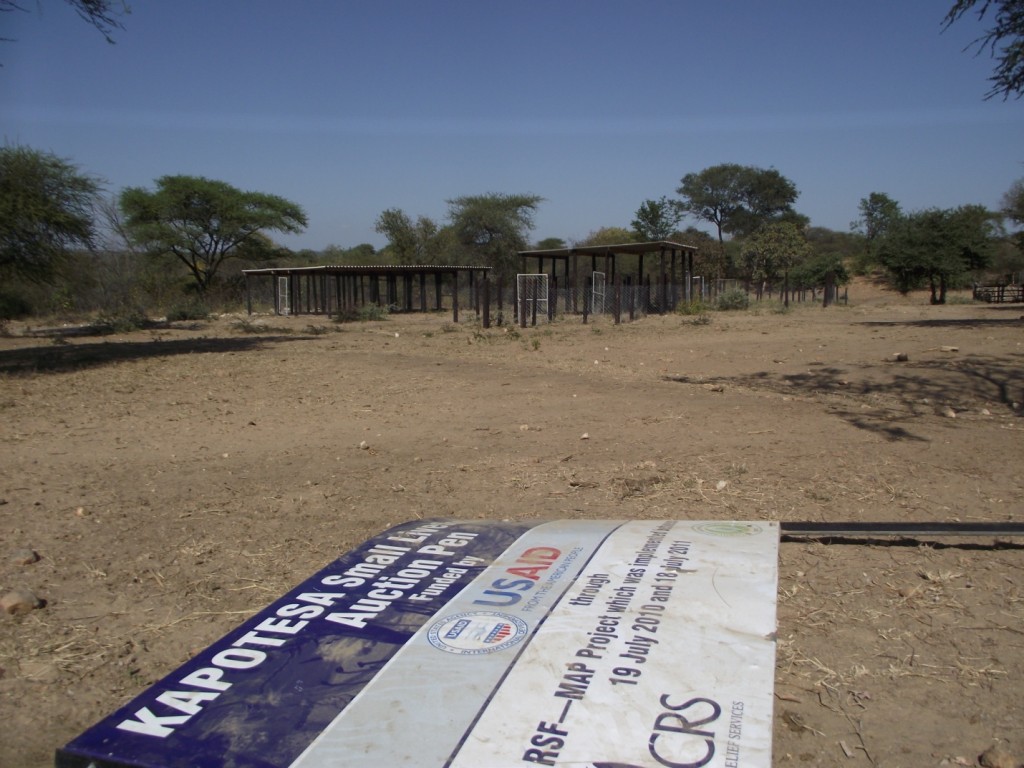
This picture was taken less than a year after the Kapotesa Small Livestock Auction Pen was established in Mudzi District. The fallen billboard has since vanished.
Two years later, I happened to pass by the same auction pens again and, lo and behold, the pens were now buried by bush. I took some more photos.
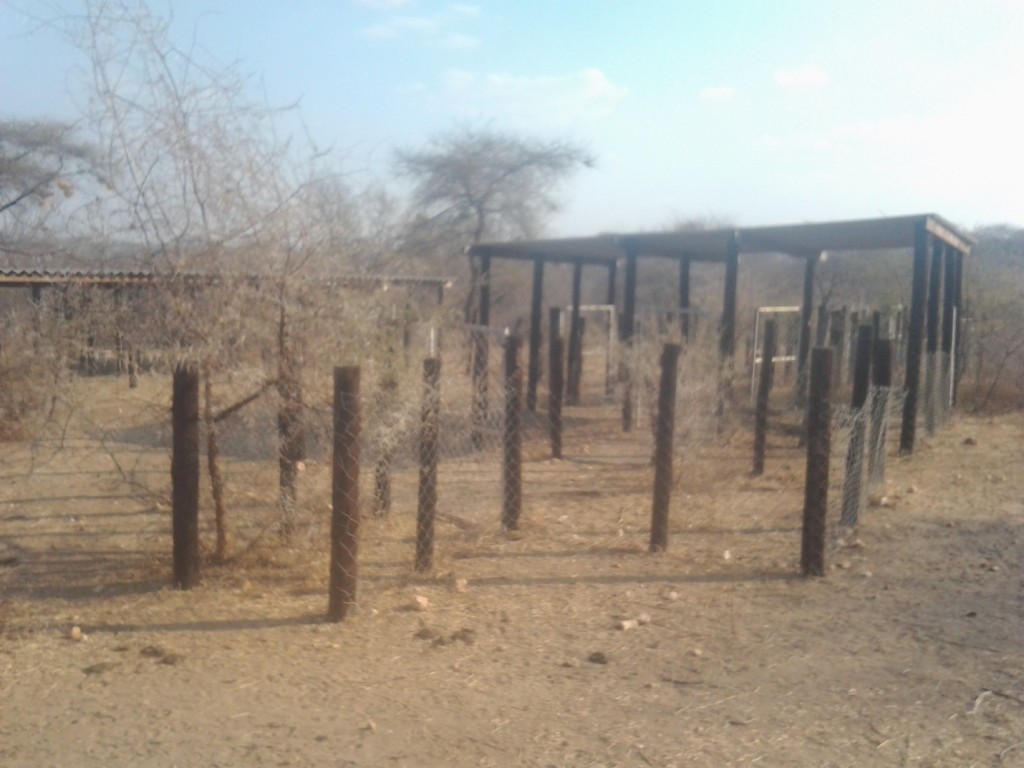
More than three years after the Kapotesa Small Livestock Pen was constructed the project is showing every sign of failure.
According to Mudzi District Council officials, all the auction pens established in the northeastern district bordering Mozambique have become “white elephants” because each time auctions have been organised, buyers have boycotted the sales preferring to engage directly with individual villagers selling livestock at bargain prices.
“There is very little we can do about these white elephants, because it’s difficult to force the buyers to come for the auctions where we hoped they would compete against each other for the benefit of the communities,” said one council official, who adamantly refused to be named for fear of recriminations. The government is very eager to portray its economic revival blueprint, the Zimbabwe Agenda for Sustainable Socio-Economic Transformation, as succeeding everywhere, despite the backdrop of a country grappling with an unrelenting economic crisis.
When the auction pens were established, it was hoped that Mudzi District Council would charge a 2 per cent auction levy to help it maintain the auction sites. Since not a single cent has been realised from the projects, the auction pens were left to crumble.
Another major obstacle to the project was that auctions were meant to take place on specific dates. Yet villagers face problems requiring money almost every other day, and thus they cannot wait until a set date to sell their livestock to solve a pressing matter.
While USAID and many non-governmental organisations (NGOs) sincerely pump billions of dollars into struggling economies, hoping to make a difference, communities that receive this assistance need to be fully consulted to make the most of such initiatives. The Mudzi small livestock auction pens are a typical example.
The initiative had ‒ and still has ‒ the potential to help secure more stable and potentially higher incomes for the poor and vulnerable communities of Mudzi. But with the communities lacking knowledge on how to utilise the auctions to their collective and individual benefit, sustainable development remains NGO mumbo jumbo.
Although all NGO initiatives in Zimbabwe are sanctioned by the government, there do not appear to be systems in place to help sustain them. After establishment, many programmes crumble soon after being handed over to communities simply because the sense of ownership and continuity is absent. When the Mudzi project was handed over, its operation remained the preserve of the council and the villagers’ traditional way of doing business remained intact. They were never informed how and when their livelihoods would be changed by the programme.
The failure of programmes in remote corners such as Mudzi might be non-events for USAID, an organisation that pumped US$900 million in humanitarian assistance into Zimbabwe between 2002 and 2008, as well as millions of dollars in other developmental programmes. But for poor and vulnerable communities, such failures are a painful reminder of their perpetual dependency on humanitarian assistance, as food insecurity and underdevelopment continue to haunt them day in, day out, simply because their mainstay of agriculture remains unsustainably poor and weak.
-
 Issaka Adams, 25, is a freelance journalist from Ghana who is currently studying at the Ghana Institute of Journalism. He hopes to enter a graduate programme in International Development and then specialise in International Development Journalism. “I want to use my journalistic works to transform and develop my country,” he explains.
Issaka Adams, 25, is a freelance journalist from Ghana who is currently studying at the Ghana Institute of Journalism. He hopes to enter a graduate programme in International Development and then specialise in International Development Journalism. “I want to use my journalistic works to transform and develop my country,” he explains.Issaka’s Second Prize Winning Article
Emerging issues from Ghana’s oil exploration activities
Ghana discovered its offshore oil and gas Jubilee Field in 2007. By 2010, it had started pumping the first oil – a historic moment. Since then, oil has been produced in commercial quantities, and over the next 20 years it could earn up to US$20 billion in export revenue for the country. It is expected that this will present an opportunity for the growth of the country’s economy, reducing the poverty rate amongst the people living in the coastal towns where the exploration work is carried out.
Four years after entry into the oil business, critical issues have begun emerging from communities living close to where the exploration takes place. The sea provides a major source of employment for people living in the coastal towns. They fish to get their daily bread. But recently, their work has virtually halted as a result of the frequent washing ashore of dead whales.
Between August 2013 and August 2014, the carcasses of 22 whales appeared on the beaches of Ghana. Traditionally, in the coastal towns such an occurrence was seen as a sign of a bumper harvest of fish, and the local people celebrated and made merry. They buried the whale and gave it a befitting funeral, just like a human being. This was the practice in the olden days.
The number of dead whales recently has changed people’s ancient beliefs. They are now worried. Whenever a dead whale is washed ashore, they are out of business. They cannot undertake their daily work routines until the mammal has decomposed.
In Asanta, a small fishing village of about 2,000 inhabitants located in Ellembele District in the Western Region, more than seven dead whales have appeared. The chief fisherman of the village, Joseph Ebambay, explained in an interview that this development was unusual in the past and blamed it on the oil exploration in the area.
“I can say there is a change in the environment, because we are now having oil fields and oil companies running within our deep seas. So, you cannot deny the fact that, as we say, it may be because of the oil find. We may be thinking like that, we may be thinking because of the oil drilling some chemicals fell into the sea and maybe these whales … drink some of the water or whatever it is,” said Mr. Ebambay.
Not only the chief fisherman and his people in the village suspect the oil exploration. At the Department of Marine and Fisheries Sciences at the University of Ghana, Professor P. K. Ofori-Danson, a sea mammal expert, said in an interview, “the frequency of the occurrence of death is going higher. What new thing have we put there that made it go high? The sound waves inserted into the ocean floor during the exploration are 100 times the sound of a jet plane taking off. So, if you send strange waves to the sea bed, it interferes with [the whales’] echo-location and prevents them from moving, and they are likely to swim to the shallow area of the sea and eventually be washed ashore. So we suspect the oil drilling.”
The central government representative in the area is worried about the rate at which the dead mammals are being found. District Chief Executive Daniel Eshon said Ghana’s Environmental Protection Agency (EPA) is not doing enough to help solve the problem, but declined to comment on whether oil exploration is responsible for the death of the mammals or not.
“It will interest you to know that if it happens, the EPA people will call and say try and solve this problem, because they think that as the assembly is there ‒ the assembly is the local government in this particular area ‒ so you have to oversee everything. So in this case, most of the time, they rely on me to solve these kinds of issues. But for them … [to] do this kind of post mortem and proper analysis to determine the cause of death of the whale, they will not come,” he said.
Before oil exploration began, an environmental impact assessment was done for the government by the companies involved. In the assessment, it was identified that the exploration could cause some potential threats to marine mammals. But the mitigation measures that were outlined to reduce these threats have not been properly reviewed by Ghana’s environmental authorities.
Friends of the Nation, an environmental issues NGO, has kept a close eye on the incidents and said in an interview that people in the area have reason to believe that the oil activities are responsible, since it was predicted that it could happen. But the environmental authorities have denied that the deaths of the mammals could be linked to oil extraction.
‘You must have evidence to say so; there has been speculation as to whether the oil activities might be responsible for this, [that] by generating seismic sounds that could disorientate the whales. But recent studies by the International Union for Conservation of Nature have shown that the evidence does not support it,’ maintains Carl Fiati, the EPA’s deputy director of natural resources, marine and costal environment.
Ghana’s environmental authorities are not making any concerted effort to uncover the mystery behind the deaths of the whales. Meanwhile, the migration period of the whales has just begun this year. From August till March they will be traversing Ghana’s waters, and probably more of them will be washed ashore, which will continue to disturb communities living along the coast.
-
 Valentine Obara, works for Kenya’s Nation Media Group. Mr Obara specialises in reporting on rural developmental issues, in particular agriculture, environment and public health. In 2013 he was runner-up in the National Aids Control Council Red Ribbon Awards for a feature story highlighting concerns over the long-term availability of adequate anti-retroviral drugs in Kenya.
Valentine Obara, works for Kenya’s Nation Media Group. Mr Obara specialises in reporting on rural developmental issues, in particular agriculture, environment and public health. In 2013 he was runner-up in the National Aids Control Council Red Ribbon Awards for a feature story highlighting concerns over the long-term availability of adequate anti-retroviral drugs in Kenya.Valentine’s Third Prize Winning Article:
Agroforestry Offers Better Livelihood to Kenyan Community
While tilling his one-acre piece of land at Nyadenda village, Suba sub-county of Homa Bay County, Nelson Onunga recalls his childhood years when such hard work would pay off. “In those days, we used to receive enough rainfall and we would have a bumper harvest for two planting seasons in a year, but nowadays it is hard to plant for two seasons because of the changes in climate,” says Mr Onunga.
In his view, the situation has been deteriorating over the years since population growth pushed some members of the community to seek alternative ways of earning a living. Ultimately, the residents discovered that they could make a fortune from the production and subsequent sale of charcoal, hence the once thick forests in the hills surrounding the region became a casualty.
That was about 30 years ago. Now the community is faced by the ravages of environmental degradation. The lush hills of the region overlooking the clear waters of Lake Victoria, in the far south of former Nyanza Province, were rendered bare and exposed to soil erosion from the wanton felling of trees.
Unlike the majority of the Nilotic lakeside communities that largely depend on fishing for their livelihoods, the Suba are a farming community due to their Bantu origin. Therefore deforestation, which led to destruction of water catchment areas, caused a major setback to their means of living.
In a bid to reverse the damage, a novel initiative was set up in the region in 2008. Green Forest Social Investment Ltd (GFSI) was established to focus on commercial tree farming and processing, in a manner which encourages agroforestry and social entrepreneurship. “Everybody knows it’s important to plant trees, but if you’re poor then you will have other priorities than tree planting,” says Marco Venendaal, general manager of GFSI. “There needs to be a means to convince them to do so by making it a commercial practice.”
GFSI is involved in the production of charcoal, bio-fuel and bio-gas. The community is the main supplier of raw materials. The initiative also manufactures honey, and bee-keeping contributes positively to agroforestry. By the year 2011, more than a million trees had been planted on over 1,000 acres of land in the region, with local outgrowers being financed by the company in terms of farm inputs such as seedlings and bee hives.
Upon maturity, farmers “harvest” their trees, which are sold to the factory, which makes environmentally-friendly charcoal. “We do not cut down the entire tree, but carry out sustainable harvesting so that even as the farmers earn from what they collect, the tree is allowed to continue growing, because reclaiming the environment is one of our main concerns,” says Mr Venendaal.
The charcoal-making process also involves the use of modern technology which prevents carbon emissions during production. Robins Ontita, the factory manager, elaborates on how gases that could otherwise have been released into the atmosphere are trapped in tightly-sealed burning chambers and re-used to produce energy utilised in heating the wood. “Heating is only done once, after which the machine can transfer heat from one vessel to another. Thereafter, no more energy is required and in the process there is no gas emission into the environment,” he explains.
The end product is capable of producing more heat than normal charcoal; hence, less is required for fuel, which translates to a lower quantity of wood fuel required by consumers. “The technology is capable [of producing] 900 tonnes of charcoal per year, whereby three kilograms of wood produce one kilogram of charcoal. On the other hand, it takes about five times that same amount of wood to produce a kilo of charcoal using traditional methods,’ says Mr Ontita.
The honey production factory seeks to make good use of flowering trees such as Acacia xanthophloea, the fever tree. Other tree species grown include Markhamia lutea, wattle tree, croton, silky oak and cassod tree, which take between two and four years to mature.
Statistics from Kenya’s Ministry of Environment, Water and Natural Resources show that about 80 per cent of the population depend on wood fuel for domestic energy needs and for use in informal rural industries, such as brickmaking. This has been cited as the main driver of deforestation and land degradation in a country that is struggling to implement green economy policies and programmes.
According to a 2014 report commissioned by the United Nations Environment Programme, Kenya seeks to promote the maintenance of forest cover on at least 10 per cent of all agricultural land in a bid to mitigate the effects of climate change and global warming. “The addition of trees to farms offers an opportunity for farmers to increase farm productivity and diversify their incomes, and helps combat soil erosion and nutrient depletion by providing a more balanced agro-ecological profile,” the report states. It is currently estimated that Kenya’s forest cover stands at 6 per cent, against the constitutional target of 10 per cent.
-
 Asha is a 22 year old writer and poet, studying at Moi University. Born and raised in Kibera, Nairobi’s largest informal slum, Asha writes about issues affecting people there. “The world is full of people writing negative stories about Kibera but I am putting up a hard fight,” she says. “I believe that being young is not a problem, the problem is being young and not doing anything.”
Asha is a 22 year old writer and poet, studying at Moi University. Born and raised in Kibera, Nairobi’s largest informal slum, Asha writes about issues affecting people there. “The world is full of people writing negative stories about Kibera but I am putting up a hard fight,” she says. “I believe that being young is not a problem, the problem is being young and not doing anything.”Asha’s Special Award Winning Article:
Failed Donor Aid
Ever been made to feel like you are not needed and belittled? That’s what is happening in every slum. In every place that the world is always trying to help. We are so busy helping and forget that at some time we need to stop and look. Are we bringing any change? In Kibera, there are more than 200 NGOs trying to bring change. I appreciate them all, but can they please end that right now! How many years have we had organisations trying to help and they end up not doing what they are supposed to?
There is something going on in the slums; we are not looking, but it happens every day.
Commercialisation. We are being commercialised or rather, in a more familiar term, being “helped”. We are used to meet the dreams of so many ambitious peeps. We are the “slummers” or better yet slum dwellers.
“Kibera is the second-largest slum in Africa/the world.” It depends where you are getting your statistics. This has become a cliché. I know, right? Kibera has been painted the dirtiest, scariest, most poverty-stricken place in the world, but I have a different story.
Kibera is one of the biggest slums in the world? Yeah, yeah, but have you been there? No? Yes? No, right! I thought so. You do not know. So, let me tell you about it. Kibera is filled with the most talented, most innovative, most skilled people in the world. But the world doesn’t want to see that, or rather the organisations feeding from it won’t see it. Why? Because it will not bring money to these poverty-stricken people. Sad stories sell, I hear. So, why not spread all the bad things about Kibera to the world and maybe we can get more donors?
All these organisations spread about Kibera want to help, or bring social change, but let’s look at it. How many years have we had these NGOs? Twenty years? Thirty years? And nothing has changed, right? Come on, look at the statistics. Kibera is getting worse, but we have people bringing in donors to help, sending proposals here and there all in the name of ending poverty. Kibera may be just a place people are using to fill their bank accounts, and a lot of organisations do not know the importance of involving people in their work. How do you end poverty without involving the poor people you are trying to help?
Involve people. That is what we need to do. The only way Kibera can stop being poverty-stricken is when the slum dwellers are allowed to control their own business. Leave the slum dwellers to do what they want with their place. Leave the duty of change to the oppressed.
The world is so busy entering into places and bringing in money, but not looking at the specifics of people living in those places. Ask people what they want and maybe the world will change in an instant. You involve people living in the place you want to change ‒ they know these places, and they know what can work and what cannot work. We need to stop imposing our rules and great ideas on people. It is not fair when people come to your house and tell you how to live your life.
It is easy to sign a proposal and release a large sum of money to help people, but I have lived in Kibera and I know that it is not fair when we have people who make decisions for us. Let us scrap the aid thing and let us do more with society. Involve people; ask them to come up with their own agendas and ideas. Maybe they are not living in poverty, as the world perceives; maybe they are not as dangerous and angry people as so many people may think. I, for one, am a talented woman who wants to see my myself getting involved in changing my society, not sitting and seeing people come to my home and coming up with proposals about how to change the slum I have lived in all my life.
It starts with organisations not imposing their ideas. Let the people feel powerful, not inferior. What do these organisations want to do? They want to help end poverty, but end up involving people who’ve never seen poverty in their lives.
The only way we can bring change is by letting the people do all the work and change their own societies. Change is inevitable, yeah, but change comes from inside, and I believe that the only way we can do that is by letting every person who needs help to help themselves. Change can be achieved that way.
This may sound a little harsh, but NGOs are not helping ‒ they bring more problems than solutions. I have to say that they should leave us alone. They should be replaced by dedicated community leaders. Let people change themselves.
Dear NGOs, you have failed us. Now we want to change our societies.







